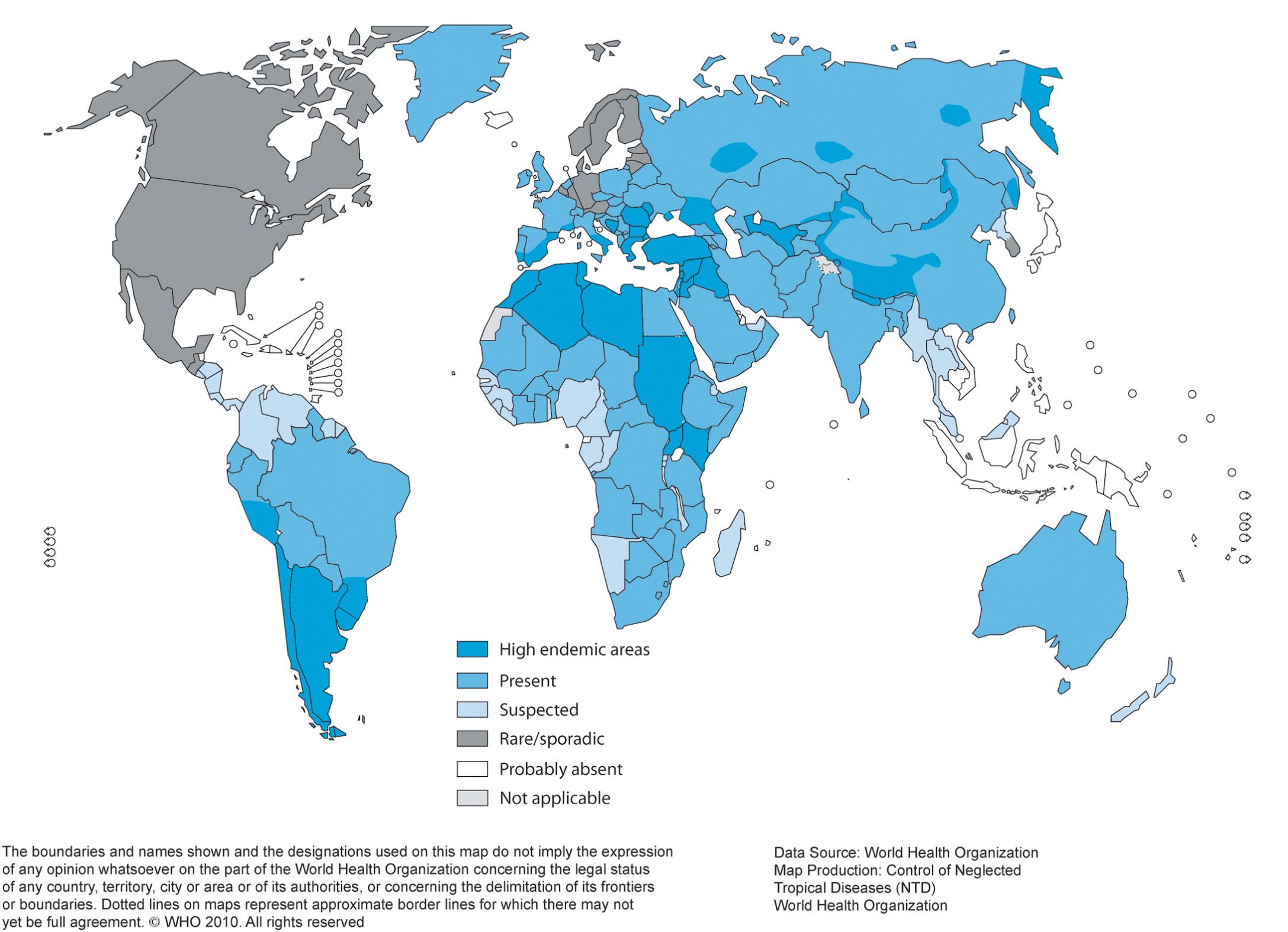Physical Address
304 North Cardinal St.
Dorchester Center, MA 02124
Echinococcosis ( hydatid disease or hydatidosis ) is a widespread, serious human cestode infection ( Fig. 330.1 ). Two major Echinococcus groups of species are responsible for distinct clinical presentations. Echinococcus granulosus and related species cause cystic hydatid disease, and Echinococcus multilocularis causes alveolar hydatid disease . The adult parasites are small (2-7 mm) tapeworms with only 2-6 segments that inhabit the intestines of canines such as dogs, wolves, dingoes, jackals, coyotes, and foxes. Canines are infected by ingesting contaminated viscera from ungulates ( E. granulosus ) or mice ( E. multilocularis ). These carnivores pass the eggs in their stool, which contaminates the soil, pasture, and water, as well as their own fur. Domestic animals, such as sheep, goats, cattle, and camels, ingest E. granulosus complex eggs while grazing. Some species of E. granulosus complex have a sylvatic cycle involving wild cervids such as moose, elk, and deer. For E. multilocularis , the main intermediate hosts are small rodents. Humans are infected by consuming eggs by direct contact with infected canines or from ova in the environment. In Europe, contamination of gardens by fox excrement is a major risk factor for transmission. The larvae hatch, penetrate the gut, and are carried by the vascular or lymphatic systems to the liver, lungs, and less frequently, bones, kidney, brain, or heart in E. granulosus infection. E. multilocularis larvae infect the liver almost exclusively.

Echinococcus granulosus complex comprises several recognized species previously arranged in genotype groups. These are E. granulosussensustricto (G1-G3), E. equinus (G4), E. ortleppi (G5), and E. canadensis (G6-G10). The species within the E. granulosus complex show significant variation not only in genetics but also in ecology. While E. granulosussensustricto is mainly found in domesticated ovines and dogs around the world, E. canadensis is found in a sylvatic wolf/moose cycle in North America and Siberia and has been identified in bovines and swine in South America.
There is potential for transmission of E. granulosus to humans wherever dogs are allowed to ingest the entrails of herd animals. Cysts have been detected in up to 10% of the human population in northern Kenya and western China. Disease is highly endemic in the Middle East and Central Asia. In South America, the disease is prevalent in sheepherding areas of the Andes, the beef-herding areas of the Brazilian/Argentine Pampas, and Uruguay. Among developed countries, the disease is recognized in Italy, Greece, Portugal, Spain, and Australia, and is reemergent in dogs in Great Britain. In North America, transmission rarely occurs through a sylvatic cycle in the Arctic, as well as in foci of the domestic cycle in sheep-raising areas of western United States.
Transmission of E. multilocularis occurs primarily in Western China, Central Europe, Siberia, and Turkey. Transmission is now rare in the Arctic regions of North America. Ingestion of infected rodents by dogs or foxes facilitates transmissions to children. Separate species, E. vogeli and E. oligarthrus , have mainly a sylvatic cycle involving canines and felines that causes polycystic disease in northern South America.
E. granulosus complex parasites are often acquired in childhood, but cysts require many years to become large enough to be detected or cause symptoms. In children the lung is a common site, whereas in adults up to 70% of cysts develop in the liver. Cysts can also develop in bone, the genitourinary system, spleen, subcutaneous tissues, and brain. The host surrounds the primary cyst with a tough, fibrous capsule. Inside this capsule, the parasite produces a thick lamellar layer with the consistency of a soft-boiled egg white. Inside the lamellar layer is the thin germinal layer of cells responsible for production of 1000s of protoscoleces that remain attached to the wall or float free in the cyst fluid ( ). Smaller internal daughter cysts may develop within the primary cyst capsule. The fluid in a healthy cyst is clear, colorless, and watery. Rupture of the cyst, which can occur spontaneously, with trauma, or during surgery, can be associated with immediate hypersensitivity reactions, including anaphylaxis. Protoscoleces released into the tissues can also develop into new cysts.
E. multilocularis almost always involves the liver. The lesions grow very slowly and rarely present in children. The secondary reproductive units bud externally and are not confined within a single, well-defined structure. Thus the lesions are invasive and often confused with a malignancy. Furthermore, the cyst tissues are poorly demarcated from those of the host, making surgical removal difficult. The secondary cysts are also capable of distant metastatic spread. The growing cyst mass eventually replaces a significant portion of the liver and compromises adjacent tissues and structures.
Become a Clinical Tree membership for Full access and enjoy Unlimited articles
If you are a member. Log in here